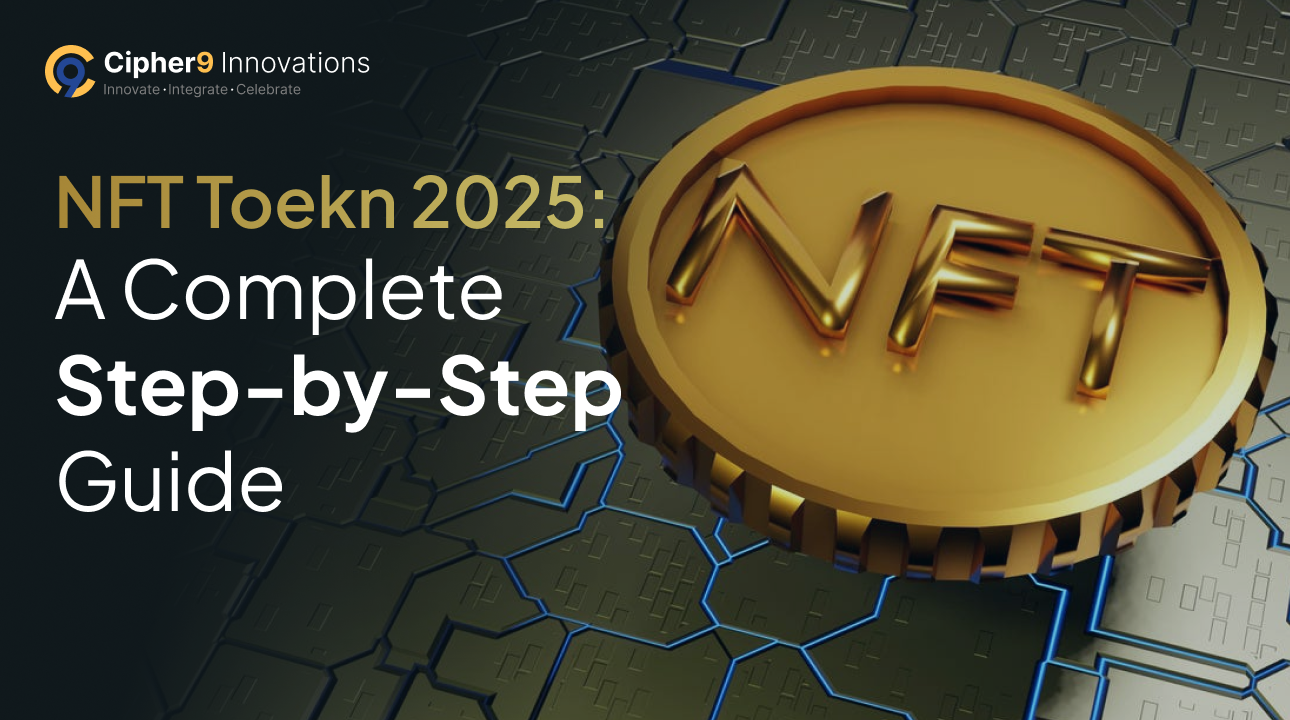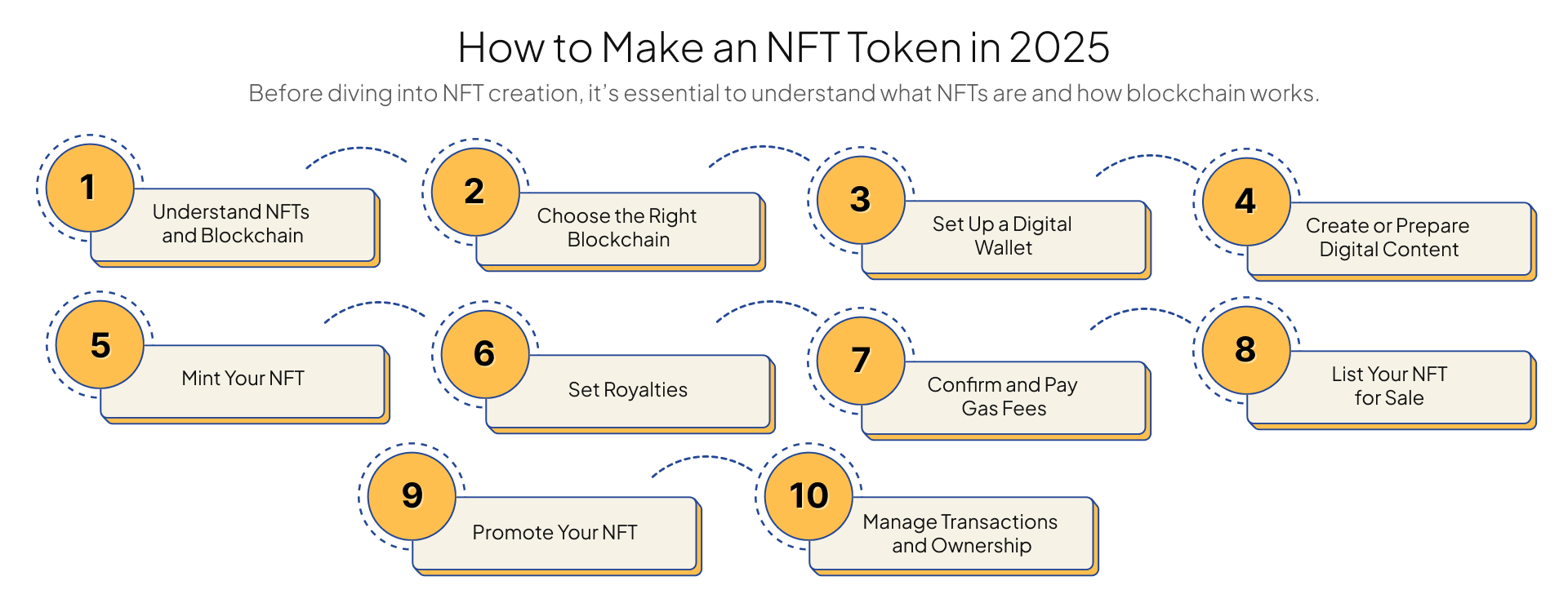
Introduction
Imagine being a musician pouring your heart into every note but struggling to earn fair compensation. Enter the world of NFTs – a revolutionary space where creators become their own record labels, connecting directly with fans who can support them and own a piece of their music forever. No intermediaries, just an engaged community sharing your passion. Suddenly, your art transforms into a symphony of opportunities, where creativity meets tangible value, and every creation resonates with purpose.
This is the power of NFTs – redefining ownership, fostering communities, and empowering creators to reshape the rules of digital engagement.
Why Create an NFT Token in 2025?
Creating an NFT token in 2025 is more than minting a digital asset; it’s about owning a piece of the future. NFTs unlock new value for your creations, build vibrant communities, and allow you to experiment with immersive and interactive digital experiences. By embracing NFTs, creators can explore innovative monetization methods, engage with supporters directly, and establish a lasting digital footprint.
NFTs provide an exciting opportunity to transform ideas into assets, where each token tells a story, preserves uniqueness, and offers long-term value. As the NFT ecosystem evolves, 2025 presents creators with the chance to innovate, connect, and thrive in a decentralized digital economy.
How to Make an NFT Token in 2025
Building an NFT token requires careful planning, a strong understanding of blockchain technology, and a clear strategy for engaging your audience. Below is a step-by-step guide for individuals and businesses looking to launch their NFT tokens successfully.

Step 1: Understand NFTs and Blockchain
Before diving into NFT creation, it’s essential to understand what NFTs are and how blockchain works.
- NFTs (Non-Fungible Tokens): Digital assets that represent ownership of unique items like art, music, videos, or virtual collectibles. Each NFT is distinct and cannot be exchanged on a one-to-one basis like cryptocurrencies.
- Blockchain: The decentralized ledger technology underlying NFTs ensures transparency, security, and immutability. Every transaction, transfer, or sale is recorded on the blockchain, guaranteeing authenticity and trust.
By grasping the fundamentals, creators can make informed decisions about the best practices and platforms for NFT development.
Step 2: Choose the Right Blockchain
Selecting the right blockchain is crucial for NFT creation. While Ethereum remains the most popular choice due to its large ecosystem and NFT standards like ERC-721 and ERC-1155, alternative blockchains offer advantages such as lower fees and faster transaction times. Some options include:
- Binance Smart Chain (BSC): Cost-effective and fast, ideal for creators seeking efficiency.
- Flow Blockchain: Optimized for NFTs, particularly in gaming and collectibles.
- Tezos: Eco-friendly with low energy consumption and growing NFT support.
Consider transaction fees, environmental impact, community adoption, and developer support when choosing a blockchain for your NFT token.
Step 3: Set Up a Digital Wallet
A blockchain-compatible wallet is essential to store and manage NFTs. Popular options include:
- MetaMask: Widely used for Ethereum-based NFTs.
- Trust Wallet: Popular for Binance Smart Chain and other networks.
Ensure your wallet is funded with the native cryptocurrency of your chosen blockchain, as it will be required for minting, gas fees, and transactions.
Step 4: Create or Prepare Digital Content
The heart of any NFT is the digital asset itself. Your content could include:
- Digital artwork or illustrations
- Music tracks or albums
- Videos or animations
- Virtual real estate or 3D assets
High-quality, engaging content with clear value will attract collectors and increase the potential for long-term success.
Step 5: Mint Your NFT
Minting transforms your digital creation into an NFT. Most platforms provide a simple process:
- Connect Wallet: Authenticate transactions via your wallet.
- Upload Content: Add the file along with relevant details, such as title, description, and properties.
- Set Editions: Decide if the NFT will be unique (1/1) or limited in multiple editions.
Minting solidifies ownership on the blockchain and makes your NFT available for sale or trade.
Step 6: Set Royalties
One of the most valuable features of NFTs is royalties. By setting a royalty percentage, creators can earn a portion of sales every time the NFT is resold. This ensures ongoing revenue and allows artists to benefit from the growing value of their work.
Step 7: Confirm and Pay Gas Fees
Gas fees cover blockchain transaction costs and vary depending on network congestion. Ethereum fees fluctuate frequently, while alternatives like BSC and Tezos offer lower costs. Always review your listing and confirm fees before minting.
Step 8: List Your NFT for Sale
Once minted, you can list your NFT on a marketplace. Important considerations include:
- Pricing: Decide on a fixed price or auction format.
- Auction Type: Options include timed auctions or reserve price auctions.
- Visibility: Make your NFT public to attract collectors and enthusiasts.
A well-optimized listing improves discoverability and increases sales potential.
Step 9: Promote Your NFT
Marketing is essential for NFT success. Strategies include:
- Social Media: Share NFTs on Twitter, Instagram, Discord, and LinkedIn.
- NFT Communities: Engage in forums and community channels to gain traction.
- Collaborations: Partner with artists, influencers, or brands to expand reach.
Active promotion builds credibility and establishes your presence in the NFT ecosystem.
Step 10: Manage Transactions and Ownership
Track NFT ownership and transactions through your digital wallet:
- Transaction History: Monitor sales, transfers, and royalties.
- Ownership Transfer: Understand how blockchain automatically handles ownership upon sales.
Engage with the community, stay updated with trends, and plan future NFT releases to maintain a strong digital presence.
How Much Does It Cost to Create an NFT Token?
The cost of creating an NFT depends on several factors:
- Blockchain Platform: Ethereum, BSC, Flow, and Tezos have varying fees.
- Smart Contract Development: Complex features increase development costs.
- Token Standards: ERC-721 vs. ERC-1155 affects functionality and price.
- Storage & Hosting: Metadata and media file hosting incurs costs.
- Minting & Gas Fees: Transaction fees fluctuate based on network activity.
- Security Measures: Audits and additional layers protect your NFT assets.
- Marketplace Integration: Listing on popular NFT marketplaces may include fees.
For a precise estimate, consult blockchain developers or NFT development agencies, as costs can vary depending on project complexity and market conditions.
Partner with Cipher9 Innovations for Expert NFT Development
Looking to create an NFT token with a flawless development lifecycle? Cipher9 Innovations offers comprehensive NFT development services with global market expertise. From conceptualization and blockchain integration to minting, promotion, and marketplace integration, we guide creators and businesses to succeed in the NFT ecosystem.
Book a free live demo today and step confidently into the world of NFT innovation.

